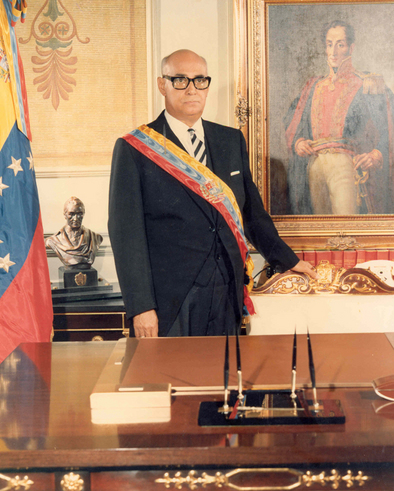- Raúl Leoni
Infobox_President | name=Raúl Leoni

order=53rdPresident of Venezuela
term_start=March 13, 1964
term_end=March 11, 1969
predecessor=Rómulo Betancourt
successor=Rafael Caldera
office2=Senator for life
term_start2=March 11, 1969
term_end2=July 5, 1972
birth_date=birth date|1905|4|26|mf=y
birth_place=El Manteco, Bolívar state,Venezuela
death_date=death date and age|1972|7|5|1905|4|26|mf=y
death_place= New York City, New York, USA
religion=Roman Catholic

party=Acción Democrática
spouse=Carmen América Fernández Alcalá (Menca de Leoni)|
website = [http://www.fundacionraulleoni.info/raul_leoni.php Raúl Leoni Foundation] |Raúl Leoni Otero (April 24, 1905 - July 5, 1972) was President of
Venezuela from 1964 until 1969. He fought against the dictatorsJuan Vicente Gómez andMarcos Pérez Jiménez , and was a charter member of theAcción Democrática party.He was born in El Manteco,
Bolívar State . Nevertheless, one of the pillars of that consolidation, the "Pacto de Punto Fijo", was underestimated by Leoni, since in his opinion it reduced the "coherence and organization of the regime". Strictly, the pact mandated that the composition of the executive cabinet be limited to representatives of three of the more important political parties:Acción Democrática (AD),COPEI andUnión Republicana Democrática (URD). Leoni initially formed a cabinet with a few members of his party and a good number of independents. Later, in November of 1964, Leoni initiated conversations with leaders of the involved parties to rescue the spirit of the pact. A new cabinet was formed, but it lasted for only 16 months.Presidency
Leoni took control of the presidency on March 13, 1964, succeeding
Rómulo Betancourt ; both were members of theAcción Democrática .During his government, Leoni carried out important structural projects in Venezuela, specifically the development of heavy industry in Guayana (hydroelectric, iron and steel), inauguration of the Bank of the Workers, and construction of road infrastructure (highways, freeways, and bridges - the most important of which crossed the
Orinoco ). Important changes to labor and social programs also occurred; unions gained force and the Social Security law was modified. Leoni made an attempt at reforming tax structure, but was restrained by a coalition of left and right that openly served the interests of oil companies.In 1967 the
Invasion of Machurucuto happened during the presidency where 12 guerrillas attempted to help Venezuelan guerrillas in the Venezuelan Andes.Also, in this same period Leoni signed the Cartagena Agreement (precursor to the
Andean Community trade bloc ) inBogotá between Venezuela,Chile ,Colombia ,Perú andEcuador .During Leoni's presidency the conflict with the leftist guerrilla movement Armed Forces for National Liberation (FALN) intensified. In 1967 he suspended constitutional guarantees.
On the March 11, 1969, Leoni transferred power to
Rafael Caldera , member of the Christian Democratic PartyCOPEI and signatory of thePacto de Punto Fijo . This transfer definitively instituted the alternation of power between the important parties through the end of the 20th century in Venezuela.References
*Much of the content of this article comes from [http://es.wikipedia.org/wiki/Raúl_Leoni the equivalent Spanish-language wikipedia article] . The following references are cited by that Spanish-language article:
* [http://www.fpolar.org.ve/encarte/fasciculo23/fasc2302.html Fundación Polar]
Wikimedia Foundation. 2010.
